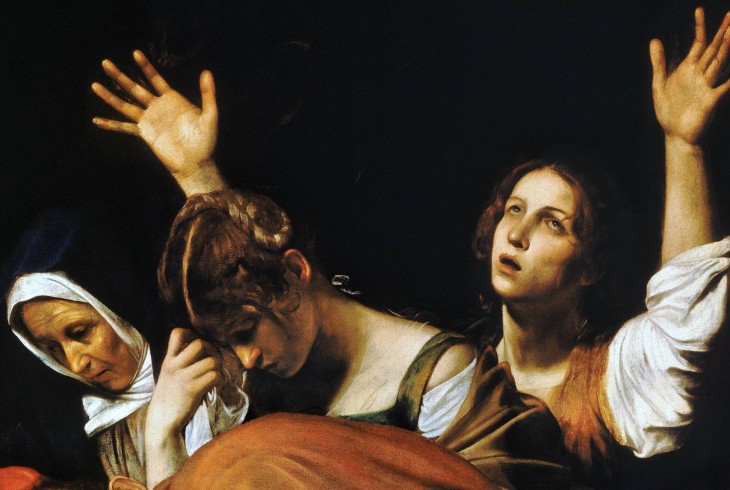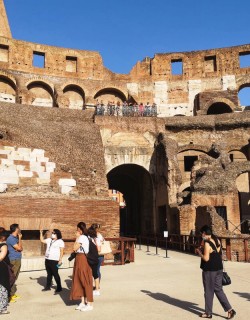Easter is the theological and emotional fulcrum of the Christian year - a week of triumph and betrayal, mourning, revelation and renewal. From Christ’s entry into Jerusalem on Palm Sunday to the tragic events of Good Friday and the triumph of Resurrection on Easter Sunday, Holy Week narrates the core mysteries of Christian belief over the course of a few jam-packed days.
Across the centuries, Italian artists have returned again and again to the Passion narrative, recounting the events of Christ’s death and resurrection in fabulous images that we can admire today in churches, chapels and galleries across the peninsula. From Venice to Florence, Rome and beyond, we can trace the arc of Holy Week through masterpieces still capable of moving the mind and stirring the soul.
To mark Easter this year, we are following that arc day by day, through the works of great masters like Giotto, Raphael, Caravaggio, and others. This is the Easter story like you’ve never seen it before!
Palm Sunday
Palm Sunday opens Holy Week with a burst of triumph. Jesus enters Jerusalem riding on a donkey, and the crowds greet him like a king, waving palm fronds to herald his arrival. But for those of us who know what’s to come, the joyful procession is shadowed by a dark edge of tension. The city that hails him today will, by week’s end, call for his crucifixion. The stage is set for the drama to unfold.
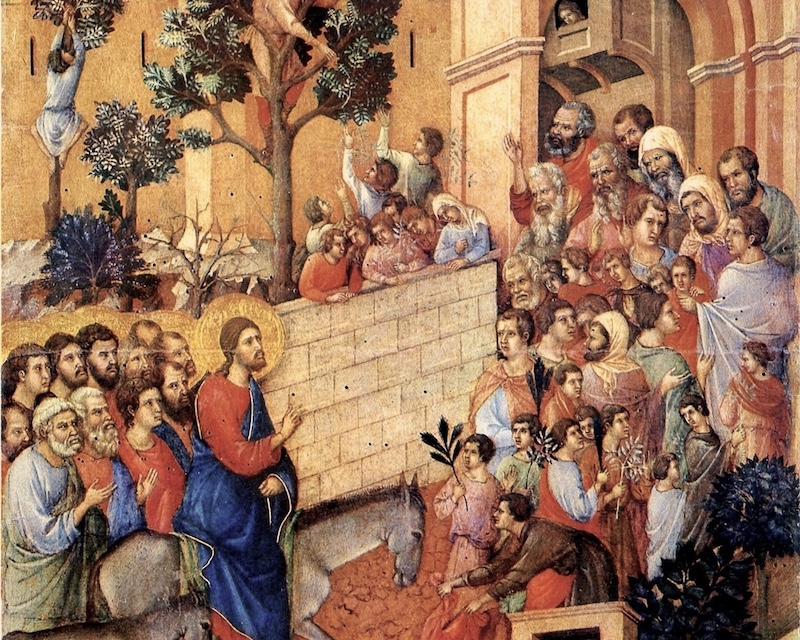
The Artwork: Duccio, Christ’s Entry into Jerusalem, c1308
Museo dell’Opera del Duomo, Siena
The artistic identity of Siena is inextricably tied to the career of Duccio di Buoninsegna, the city’s preeminent painter of the late thirteenth and early fourteenth centuries. His great masterpiece, the Maestà, was commissioned in 1308 for the high altar of Siena Cathedral - a monumental double-sided altarpiece that stood as a splendid beacon of civic pride. Its reverse is devoted to the Passion of Christ: a sweeping, cinematic cycle of 26 panels that set a new benchmark for Medieval visual storytelling.
The narrative power and technical skill of Duccio’s craftsmanship is nowhere more in evidence than in Christ’s Entry into Jerusalem. Christ arrives at the city gates from the left astride his donkey, which he had ordered his apostles to expropriate from a nearby tavern. Local likely lads pave the way by draping cloaks and palm fronds on the cobbled track, heralding the arrival of Jesus and his gang.
But what truly brings the scene to life is Duccio’s Sienese reinterpretation of Jerusalem. The crenellated towers, fortified gates, and steep, narrow streets unmistakably echo the architecture of medieval Siena. Viewers in the early 14th century would have recognized their own city in the Holy City, drawing a direct, emotional line between local space and sacred history. There’s deep human charm too: look out for the pair of boys clambering up trees to tear off palm fronds, and the little heads poking out of windows and above walls to catch a glimpse of the action.
Spy Wednesday
Spy Wednesday marks the moment of betrayal. According to the Gospels, it was on this day that Judas Iscariot, one of Jesus’ twelve disciples, conspired with the chief priests to hand Jesus over in exchange for thirty pieces of silver. This secret arrangement, carried out in the shadows, gives the day its name - “spy” meaning one who acts in secret. With this act, the Passion begins to gather its devastating force.
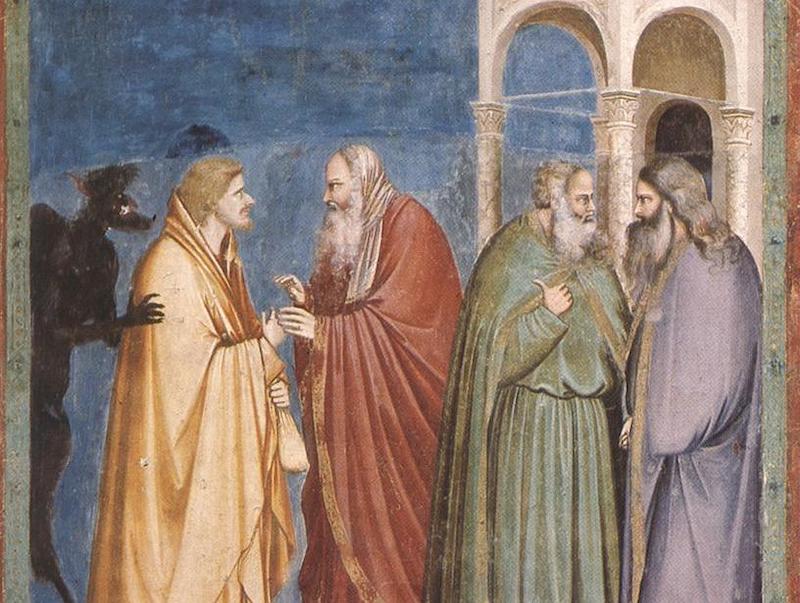
The Artwork: Giotto, Judas Receiving the Thirty Pieces of Silver, c.1305
The Arena Chapel, Padua
Giotto’s fresco cycle in the Arena Chapel is one of the great turning points in the history of Western art. Painted around 1305 for the wealthy Paduan banker Enrico Scrovegni, the chapel’s walls unfold the story of salvation in a sweeping visual narrative, from the lives of Joachim and Anna to the Passion of Christ.
Giotto’s new visual language reaches a superb height of dramatic tension in the scene of Judas Receiving the Thirty Pieces of Silver. In Giotto’s haunting fresco, betrayal begins not with violence but with a simple handshake. Beneath the arches of the high priests’ palace, Judas reaches out to seal his secret pact with the Sanhedrin. The silver coins are already in hand, a businesslike transaction carried out in silence that barely hints at the earth-shattering consequences to come.
Giotto spotlights the figure of Judas with trademark psychological intensity. Cloaked in a heavy yellow robe, its color an infamous symbol of his treachery, he leans forward with unsettling eagerness. Behind him, a devilish figure whispers into his ear and urges him on, invisible to the others but obvious to us - a chilling envisioning of temptation and the unseen forces behind the disciple's unconscionable fall from grace.
Find out more about the extraordinary Arena chapel in Padua with our in-depth guide: Giotto and the Birth of the Renaissance in the Scrovegni Chapel.
Maundy Thursday
In an upper room in Jerusalem, Jesus shares a final meal with his disciples - the Last Supper. It is here that he washes their feet in an act of radical humility, gives the commandment to love one another ("mandatum" in Latin, from which we get "Maundy"), and institutes the Eucharist. Later that night, in the uneasy quiet of the Garden of Gethsemane, he is betrayed and arrested, while his closest followers scatter into the dark. It’s all kicking off…
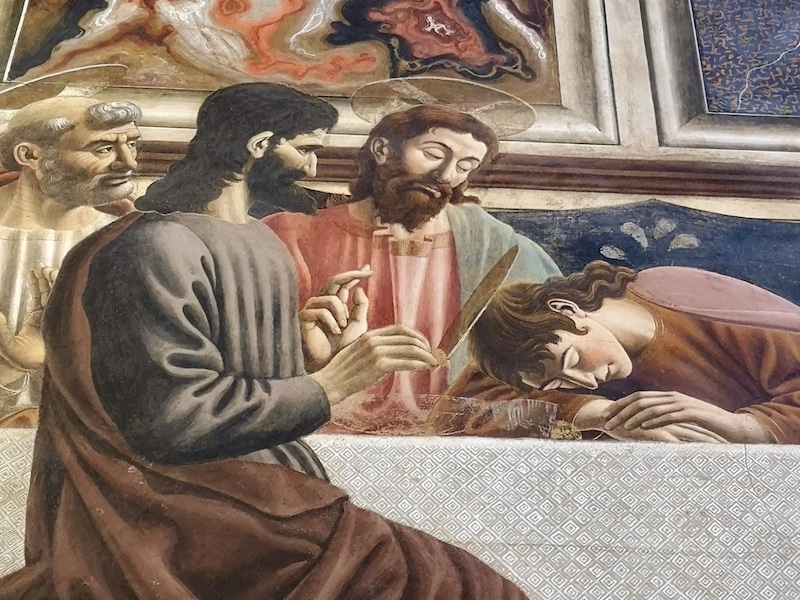
The Artwork: Andrea del Castagno, The Last Supper, c1445
Cenacolo di Sant’Apollonia, Florence
The dramatic final meal shared by Christ and his Apostles the night before he was crucified has long been one of the most popular subjects in Western art (we’re looking at you, Leonardo). In Renaissance Florence, dining halls of monasteries and convents across the city are decorated with massive frescoes depicting the theme.
One of the most impressive is found in the Benedectine convent of Sant’Apollonia, where Andrea del Castagno situates the Passover meal in a marble-panelled room rendered with dizzyingly virtuoso perspectival effects - a marvelous encapsulation of the strange, unsentimental beauty of the painter’s style.
Across the long, crisply white tablecloth, the Apostles are arranged in a tightly composed, frieze-like sequence, each figure modelled with sculptural precision. At the center Christ is calm and composed, while John slumps into sleep beside him - the faithful apostle is oblivious to the betrayal already in motion.
Across from them, isolated on the viewer’s side of the table, sits Judas. Dark-robed and hunched in shadow, he glares with heavy-lidded suspicion - does he already know that he’s been rumbled? Del Castagno leaves no ambiguity as to his role: this is the traitor, and his separation is both literal and spiritual.
Good Friday
Good Friday is the darkest day of the Christian calendar. After a rushed series of trials before Jewish and Roman authorities, Jesus is condemned to death. He is mocked, beaten, crowned with thorns, and forced to carry his cross to the hill of Golgotha. There, he is crucified between two criminals. At around 3 PM, he dies between darkened skies and trembling earth. His body is taken down and placed in a nearby tomb. It is a day of suffering and sacrifice.
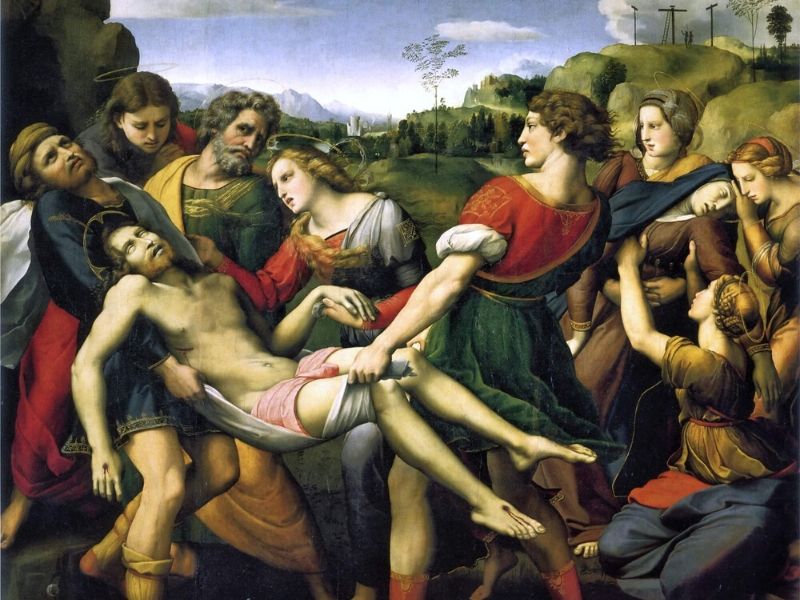
The Artwork: Raphael, The Entombment, 1507
Borghese Gallery, Rome
We are in the aftermath of crucifixion. The deed being done, there was nothing for it but to bury the body. Few Renaissance paintings communicate both narrative drama and private grief with the poise and clarity of Raphael’s Entombment, painted around 1507 for the family chapel of the Baglioni in Perugia.
The pain etched on every face here feels fresh, urgent and real. For Raphael’s patron, Atalanta Baglioni, this image of loss was intensely personal. She had commissioned the painting in memory of her son Grifonetto, slain in a Perugian blood feud just a few years earlier. As the Virgin Mary collapses in a swoon of unbearable grief, many viewers have seen a mirror of Atalanta herself, cradling her dying son.
The scene is constructed with classical precision: a group of men strains under the weight of Christ’s corpse, while Golgotha looms on the horizon. It’s a masterclass in emotional choreography: Mary Magdalene’s tender gesture as she clutches Christ’s hand, St. John’s wide-eyed anguish, the old man’s gaze that seems to reach directly toward us. At the heart of it all is the burden of Christ’s body - almost too heavy, too holy: the striking young man at the centre of the composition struggling with the messiah’s legs is probably an idealised portrait of Grifonetto himself.
The Entombement’s fame grew rapidly, solidifying Raphael’s fame. It was so admired, in fact, that it was stolen - stripped from its altar by the agents of Cardinal Scipione Borghese in 1608 and brought to Rome, where it still hangs in the magnificent Borghese Gallery, one of the glories of that remarkable collection.
Easter Saturday
In the Passion Narrative, Holy Saturday sits suspended between the grief of execution and the joy of resurrection. Jesus lies in the tomb. His followers are scattered, hiding in fear, and unsure of what will come next. According to tradition, it was on this day that Christ descended into the realm of the dead in Limbo - the Harrowing of Hell - to liberate the righteous souls who had lived before his time. On earth, it is the Sabbath, and a heavy stillness settles over the land.
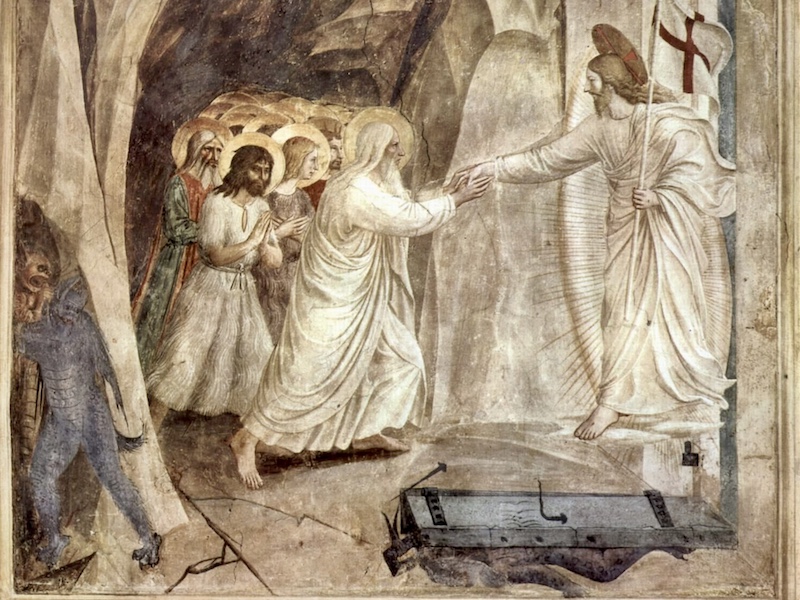
The Artwork: Fra Angelico, The Harrowing of Hell, 1440s
San Marco, Florence
In a quiet cell in the Dominican convent of San Marco, Florence, Christ has just smashed down the gates of Hell. The battered doors lie beneath his feet, and a demon has been flattened outright in the divine impact. Satan meanwhile cowers in a corner, slinking away into the gloom. But despite the drama of the moment, Fra Angelico renders the scene with the same tender gravity that defines his sacred art.
This small fresco is one of many painted by the Dominican friar and artist known to posterity as Fra Angelico in the monastic cells of San Marco in the 1440s. The convent had recently been rebuilt under the patronage of Cosimo de’ Medici, and was home to a strict branch of the Dominican order. Into this austere setting, Fra Angelico introduced his own form of visual devotion: a series of spare, luminous frescoes painted for the silent contemplation of the friars who lived there.
In the Harrowing of Hell Christ, clad in radiant white, strides into a cavernous space that blends seamlessly with the rough-plastered wall of the cell itself. He grasps the wrist of an ancient Adam, whose aged features underscore his symbolic role as the fallen progenitor of humanity. Behind them we can identify Eve and John the Baptist amongst the liberated throng.
Unlike some depictions of the Harrowing that show gaping hellmouths or fiery torments, Fra Angelico’s vision is almost classical: hell is conquered through shining light, order, and grace.
Easter Sunday
Before dawn, the world is forever changed. When women go to the tomb to anoint Jesus' body, they find the stone rolled away and the grave empty. Angels appear with a message: “He is not here; he is risen.” Jesus begins to appear to his disciples - first to Mary Magdalene in the garden, then to two travelers on the road to Emmaus, and later to the others in Jerusalem. Fear turns to joy, death to life. This is the heart of the Christian faith: resurrection.
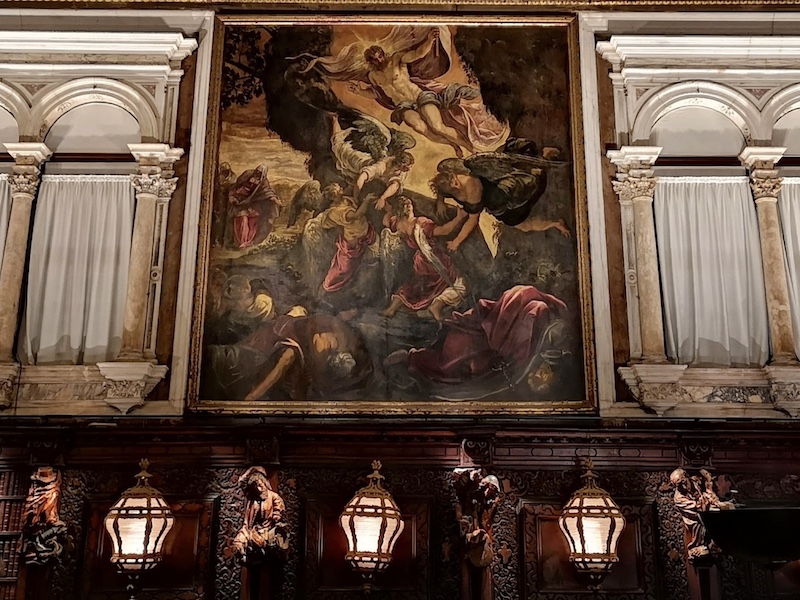
The Artwork: Tintoretto, The Resurrection, 1581
Scuola Grande di San Rocco, Venice
Christ rises in a blaze of movement and light. The heavy lid of the tomb flies open, flung aside by four straining angels whose wings and limbs twist in the force of the moment. A shaft of divine light pierces the gloom, illuminating Christ’s levitating form as he surges upwards, weightless, radiant, and utterly alive. His white burial cloth unfurls behind him like a victory banner. In the half-light at left, the Three Marys approach, still unaware of the miracle unfolding before them. Their human, hesitant path toward revelation makes Christ’s dazzling emergence feel all the more overwhelming.
This is Tintoretto’s Resurrection, one of the crowning works of the extraordinary Scuola di San Rocco in Venice. Tintoretto won this prestigious commission with typical bravado, audaciously installing a completed painting at the Scuola without permission, almost daring the resident confraternity to reject it. They didn’t, and over the next two decades Tintoretto transformed the Scuola into his very own Venetian Sistine Chapel, with vast canvases climbing ceilings and flickering across wood-panelled walls in a blaze of religious fervor.
Like all of Tintoretto’s work in San Rocco, the Resurrection is permeated with a visual urgency perfectly aligned perfectly with the ideals of the Catholic Counter Reformation: art as an immediate, affecting, and overwhelming experience. Christ's triumph over death has never felt so electric, so utterly alive.
See Tintoretto's extraordinary San Rocco frescoes for yourself on an Art Tour of Venice.
Easter Monday
Easter Monday marks the continuation of the Resurrection story. On the same day that Mary Magdalene found the empty tomb, two disciples left Jerusalem and journeyed toward the village of Emmaus, hearts heavy with grief. Along the way, they were joined by a mysterious stranger who opened the scriptures to them, explaining how the Messiah had to suffer before entering into glory. Only later at supper did they recognize him: it was Christ himself. In that instant, he vanished.
The Artwork: Caravaggio, The Supper at Emmaus, 1606
Pinacoteca di Brera, Milan. Currently on loan at the Palazzo Barberini, Rome
The road to Emmaus is long, and Caravaggio makes sure we feel every step. In this quietly devastating painting, currently on loan at the Palazzo Barberini Caravaggio exhibition, the risen Christ sinks into his chair like a man bone-tired after days of dust and sorrow. The setting is austere, the meal simple: a crust of bread, a jug of wine.
One disciple leans in, trying to believe what his eyes are telling him. The other grips the table in front of him, frozen. The paunchy innkeeper surveys the scene somewhat quizzically. There is no gasp of recognition, no raised hands or wide eyes like in Caravaggio’s earlier version of the same subject in London’s National Gallery; only silence, hesitation, and the first glimmers of understanding.
Caravaggio painted this work while in exile, a fugitive after killing a man on the streets of Rome. Haunted and hunted, he seems to pour his own weariness into the somewhat downcast canvas. The Christ he gives us is not some radiant divine visitor, but a gaunt fellow traveller that seems to speak to long roads and uncertain homecomings. In this shadowy inn, the miraculous and the everyday converge: a flicker of grace at the end of a weary day.
Though the Gospel places the Supper at Emmaus on the evening of Easter Sunday, the emotional landscape that Caravaggio conjures is consistent with a world in the aftermath of revelation, when the trumpets of resurrection have faded and the real work of belief begins - an appropriate theme for the Monday that closes the Easter period.
If you'd like to see Caravaggio's masterful Supper at Emmaus up close, then be sure to check out our exclusive guided tour of the Caravaggio exhibition at the Palazzo Barberini here!
We hope you enjoyed our guide to some of the great Easter masterpieces in Italian art! Coming to Italy this Easter? Through Eternity have been leading expert-led itineraries in Rome, Florence and Venice for over 25 years, so whatever you're interested in, we've got you covered! Check out our range of Rome tours here.
MORE GREAT CONTENT FROM THE BLOG:
- 5 of the Best Easter Foods in Italy
- The Best Things to Do in Rome this Easter
- The Via Crucis in Rome
- Easter Traditions in Italy
- Florence's Fiery Easter Tradtion
- Pastiera: The Story of a Neapolitan Easter Classic
- How to Visit the Vatican in 2025
- A Pilgrim and Tourists Guide to Jubilee 2025
